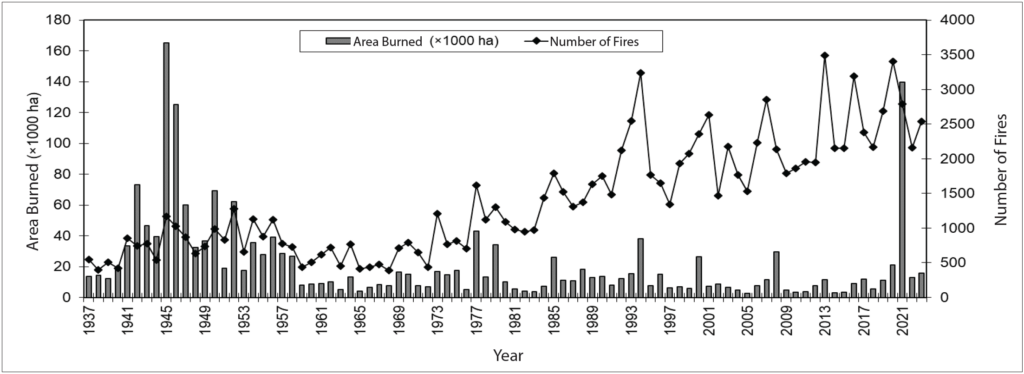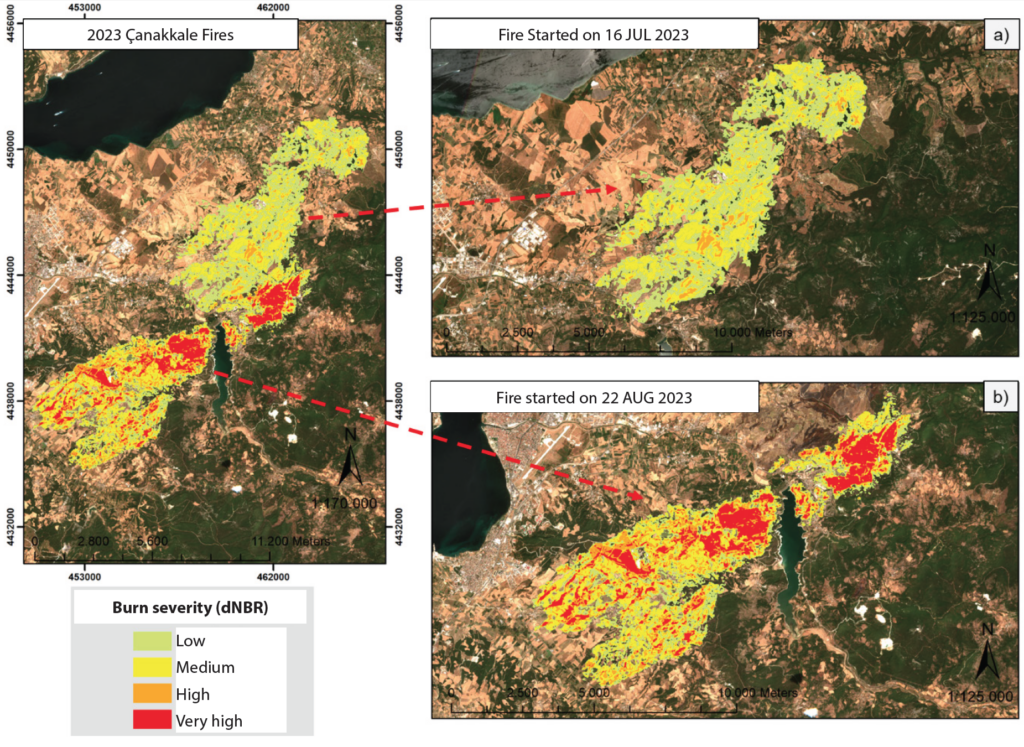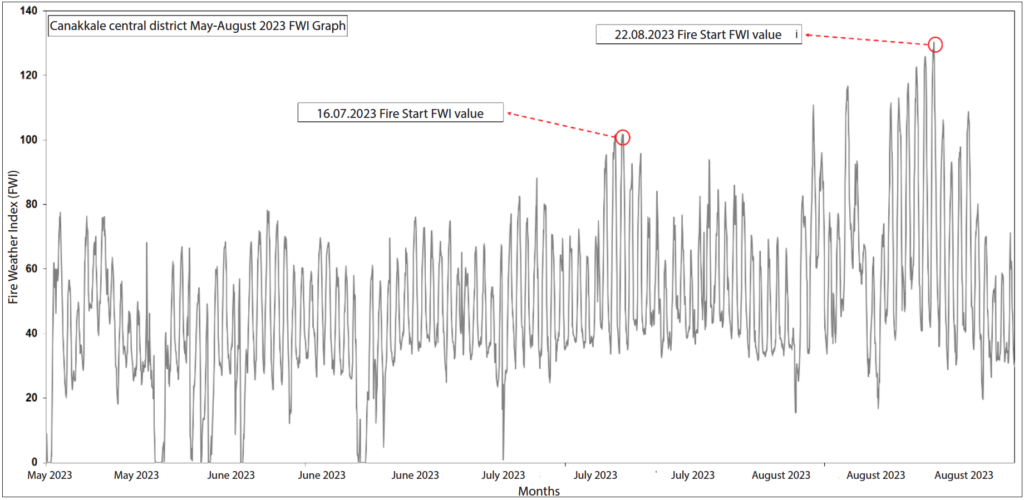Wildfires have caused serious ecological, economic, and social repercussions throughout the world in the last decade or so. As such, 2023 became known as the year that harrowing disasters wrought widespread destruction unto various regions of the earth. Canada experienced the most devastating wildfires since her founding, in which 18.5 million hectares (5.1% of the country’s total forested area) were consumed by flames as of November 2023. During the same period, wildfires ravaged an area of roughly 1.2 million hectares of American woodlands. Europe was not sparred of its share of wildfires, with Spain losing 83,937 hectares, France 22,075 hectares, Portugal 31,000 hectares, Italy 62,201 hectares, and Greece 129,332 hectares in November alone. Greece suffered particularly significant losses of life and property as a result of these fires.
The number of wildfires and total area of wooded land incinerated by these fires in Türkiye in 2023 largely resemble figures from previous years. Türkiye has maintained official statistics for forest fires since 1937. Over the eighty-seven years from this year until November 2023, Türkiye experienced a total of 1,398 fires that accounted for 21,573 hectares of damage. This averages to 20.9 hectares of charred land per incident. That said, however, the year 1988 saw significant advancements in Türkiye’s organizational and technical capacity to combat fires. In the last thirty-five years since these improvements, a total of 2,186 wildfires resulted in 14,722 hectares’ worth of land affected (seeFigure 1), translating to an average of 6.4 hectares of burned area per incident.

Figure 1 Number of wildfires and amount of area burned in Türkiye between 1937 and 2023 (2023 data as of November)
Based on 2023 figures, a total of 2,539 wildfires decimated 15,616 hectares of land between 1 January and 15 November 2023. Of the these fires, 75.3% affected less than one hectare of woodland, 19.9% between one and ten hectares, 3.5% between ten and fifty hectares, 0.6% between fifty and one hundred hectares, 0.5% between 100 and 500 hectares, and 0.2% more than 500 hectares. These figures resemble long-term data. Of the wildfires that caused more than 500 hectares’ worth of damage in 2023, however, two fires that erupted in close proximity to each other in Çanakkale, Türkiye on 16 July 2023 and 22 August are of particular significance.
These two fires were analyzed using remote sensing and geographic information systems. Differenced Normalized Burn Ratio (dNBR) indices were used to determine burn severity. To this end, pre- (14 July 2023) and post-fire (5 and 30 August 2023) Sentinel-2 satellite imagery for the affected areas were compared to determine the magnitude of wildfires and how much combustible organic material was consumed. Temporal data for the fires were monitored using satellite data obtained from NASA’s Fire Information for Resource Management System (FIRMS). The analyses found that the fire starting on 16 July 2023 raged for roughly three days and affected 2,754.7 hectares of land (agricultural, forested, and other areas). In terms of burn severity, 60.6% of the burned area was classified as low, 33.7% as moderate, and 5.7% as high. Notably, none of the areas affected experienced very high levels of burn severity (see Figure 2a). The fire that began on 22 August 2023 also lasted for approximately three days and affected 3,419 hectares of land (agricultural, forested, and other areas). With respect to burn severity, 23% of the burned area was classified as low, 30.2% as moderate, and 25.7% as high, and 21% as very high (see Figure 2b).

Figure 2 Differenced Normalized Burn Ratio (dNBR) for wildfires that occurred in Çanakkale, Türkiye in 2023

Figure 3 Fire Weather Index for Çanakkale’s central districts (1 May–31 August 2023)12
The northeasterly Poyraz wind exacerbated the severity of the fires by decreasing the relative humidity of the air in the region. The drop in relative humidity and persistent winds had the effect of rapidly drying extant dead surface material, thereby increasing the risk of spontaneous combustion. Türkiye’s online Fire Weather Index (FWI) system reported FWI values of 99 and 123 on 16 July and 22 August, respectively (see Figure 3), indicating an imminent risk of spontaneous combustion. The high temperature, low relative humidity, and exceptionally strong winds in the days leading up to 22 August depleted moisture from organic materials and caused significantly elevated FWI values. This, coupled with higher quantities of combustible surface material compared to the first wildfire, contributed to the second wildfire’s markedly higher burn severity level.
Land-based efforts were coordinated with aerial fire suppression operations were throughout 2023 in Türkiye. A total of 124 aerial vehicles—one hundred helicopters and twenty-four airplanes—were deployed over the year, marking a 17% increase in the number of aerial vehicles used during fire suppression operations compared to 2022. Aerial vehicles dropped 106,377 metric tons of water during 2023, representing a 52% increase from 2022. An additional ten unmanned aerial vehicles took part in early detection and fire monitoring operations during 2023. Land-based fire suppression efforts involved 2,453 first responder vehicles, 1,560 water tenders, and 786 heavy machinery units. In terms of manpower, 22,053 firefighters were deployed and an additional 119,000 volunteers received training in wildfire suppression.
Causes of wildfires in Türkiye
The four primary causes of wildfires are arson, human negligence, natural phenomena such as lightning, and unknown causes. A significant portion of fires whose causes are unknown can nevertheless be attributed to various human activities, such as campfires, escaped debris burning, and discarded cigarette butts. Of the wildfires originating in Türkiye between 1997 and 2022, 9% were attributed to arson, 46% to human negligence, 11% to natural phenomena, and 34% to unknown causes. These figures indicate that humans were responsible for 89% of all cases. When focusing in specifically on the areas burned, however, we observe that 19% were burned as a result of arson, 51% as a result of human negligence, 2% as a result of natural phenomena, and 28% as a result of unknown causes, meaning that a colossal 98% of wildfires affecting Türkiye’s forests were a result of human activity.
Recent statistics on wildfires reveal a notable uptick in fires originating from electrical lines compared to previous years, with 17%, 27%, and 19% of forested areas incurring damage as a result of fires along power lines in 2020, 2021, and 2022, respectively. As such, power lines passing through forests should be well maintained, combustible materials should be kept away from near power lines and transformers, and operational audits should be performed.
Firefighting operations
The fight against wildfires is a three-tiered endeavor. The taking of prevention and preparedness measures prior to a wildfire constitutes the first two tiers. As the name implies, prevention measures aim to prevent wildfires from starting altogether. Preparedness measures, on the other hand, seek to mitigate the extent of damage caused by wildfires when they do occur. The final tier involves the response strategies aimed at suppressing and extinguishing active wildfires.
By aiming to prevent wildfires from igniting altogether or minimizing their occurrence, prevention measures serve as the first line of defense against wildfires. Proactive prevention is the most effective strategy in the fight against wildfires. Since the overwhelming majority of wildfires in Türkiye are a result of human activity, with negligence being the most common cause thereof, the single most important safeguard is to conduct awareness-raising campaigns targeting residents living in wildfire-prone areas that seek to educate them about the causes of wildfires and what they can personally do to prevent their occurrence. Given this, public institutions, universities, the private sector, and civil society organizations should collaborate with one another to ensure that all the necessary steps are taken in this regard.
Preparedness measures are the second major bulwark against the threat of wildfires, as they seek to mitigate the damage and negative ecological and economic effects they cause. Safeguards generally include regulations governing the responsible management of combustible organic matter in fire-prone areas, such as roadsides, agricultural areas, and residential zones adjacent to woodlands. Fires originating near to forested areas have the potential to spread into forests themselves. Combustible matter should be disposed of systematically with proper oversight after fire risk analyses are conducted in such areas. Plans should include tree pruning to prevent vertical overgrowth and the cleanup of organic ground debris in designated areas.
Fire preparedness measures also involve managing combustible matter originating from residential zones near forested areas. As seen in the catastrophic wildfires that occurred in Türkiye in 2021, the damage caused to several villages and urban homes was not a direct result of the original fires reaching these areas. On the contrary, the damage to these areas was caused by smoldering arboreal debris and embers carried by the convection column and wind that fell onto these areas and started new fires. Though the fire did not directly reach homes and businesses, small pieces of burning bark and tree branches from the main fire landed on building roofs in nearby residential areas, causing homes and businesses to burst into flames and lives to be lost. Caution must therefore be exercised when selected building materials in fire-prone areas, especially those adjacent to woodlands. It is likewise crucial to reduce the amount of combustible matter found around homes and to use fire-resistant plant species while landscaping in residential zones. Indeed, all landscaping efforts should take into account areas’ susceptibility to wildfires. This includes the planting of trees and other vegetation throughout cities and around homes. Forest restoration and rehabilitation efforts should focus primarily on cultivating and ensuring the continuity of native species.
Suppression methods constitute the final tier in the fight against wildfires. Wildfire suppression efforts in Türkiye rely predominantly on direct interventions, such as land-based and aerial operations that utilize water to extinguish the fires. Recent advances in technology, combined with the dedicated work of all firefighting personnel and heightened public awareness, have significantly enhanced the effectiveness of wildfire management. Considerable funds have been allocated from the national budget for aerial vehicles and other firefighting equipment. Nevertheless, it is crucial to acknowledge that fire suppression operations alone do not eliminate the wildfire threat. Resources and attention dedicated to firefighting should also be directed toward prevention and preparedness efforts.
Wildfire management plans outline prevention and preparedness measures and firefighting methods to combat wildfires. Developed with input from all stakeholders, these long-term plans cover all aspects of wildfire management and are specially tailored for the unique needs of individual regions. Such plans are commonplace in countries like the United States, Canada, and Australia, in all of which wildfires pose serious threats. Similar plans are now being implemented in fire-prone regions of Türkiye, building upon pilot programs previously conducted in different parts of the country. However, issues have been noted in the creation, oversight, and implementation of these plans. Furthermore, the content of plans should be updated to incorporate modern technologies and to take into account the evolving realities of specific regions. As such, comprehensive workshops led by field experts should be organized to formulate and promulgate appropriate standards for the development and implementation of wildfire management plans. The significance of this cannot be overstated, as projections indicate a decrease in rainfall and a rise in temperatures as the ongoing climate crisis continues to escalate. Consequently, these shifts will likely result in prolonged droughts across the Mediterranean basin, including Türkiye. If these scenarios do indeed materialize, areas that already experience frequent wildfires may observe an increase in both the frequency and number of such incidents. Similarly, regions where wildfires were once relatively uncommon but that contain an abundance of combustible matter will likely see larger, more destructive wildfires in the future.
Strategies for combating future wildfires Wildfires are an inextricable and natural part of the Mediterranean basin’s ecosystem—including Türkiye. Nevertheless, changes in land use, human migration patterns, and forestry practices have altered the properties of combustible organic matter, thus precipitating a shift in the region’s wildfire portfolio. The climate crisis, the impacts of which have become increasingly felt in recent years, has resulted in short-term anomalies in weather patterns, affected the typical behavior of wildfires, and intensified the destructive power of wildfires. Large-scale, highly destructive wildfires have had profound ecological, economic, and social consequences, many of which were made manifest during the fires that engulfed large swaths of Türkiye’s Aegean and Mediterranean basin in July and August of 2021. The loss of life, evacuated residential areas, and numerous homes, tourist facilities, and agricultural areas that succumbed to these fires are but one aspect of these consequences. While long-term statistics place 2023 well within the normal threshold, necessary precautions against wildfires should be put into place in order to ward off potentially larger disasters that, given the new realities discussed above, could easily rear their head in the near future.
The following recommendations can therefore be made:
- The same amount of resources and attention allocated to fire prevention and suppression should be afforded to developing prevention and preparedness measures to prevent wildfires from occurring in the first place and to reduce the amount of damage wrought by fires that do occur.
- Fire management plans should be developed, implemented, and improved upon in areas prone to wildfires. Emerging technologies should be integrated into these plans and the unique needs of each area should be taken into consideration to bolster their effectiveness even further.
- Expensive ground-based and aerial systems equipped with state-of-the-art technologies have become indispensable in fire detection, monitoring, and suppression operations. Since it is imperative that the individuals charged with operating these systems do so effectively, technical personnel and staff must undergo specialized training tailored for firefighting operations. Despite such training, however, the desired level of effectiveness was not always achieved. As such, standards for all personnel involved in wildfire management, including pilots deployed in aerial fire suppression operations, need to be developed, regular training instituted, and audit systems put into place. This will not only prevent unnecessary loss of life and property but also enhance the effectiveness of firefighting operations.
- Fire danger rating systems equipped with the latest technologies can assist firefighting professionals make decisions pertaining to pre-fire planning, fire suppression, and post-fire operations. It is thus imperative to develop computer-based decision support systems that can be integrated into extant fire prevention and suppression endeavors.
- Despite Türkiye’s susceptibility to wildfires and the substantial financial investment in firefighting efforts, there is a dearth of researchers in academia and the public sector studying wildfires. As such, research on wildfires should be allocated special funds and be supported through diverse government-sponsored programs. Moreover, universities should partner with the public sector both to train new researchers in wildfire studies and to ensure the practical application of research findings.
1 Governement of Canada (GOC). (2023). Canada’s record-breaking wildfires in 2023: A fiery wake-up call https://natural-resources.canada.ca/simply-science/canadas-record-breaking-wildfires-2023-fiery-wake-call/25303
2 Canadian Interagency Forest Fire Centre Inc (CIFFC). (2023). National Fire Report https://www.ciffc.ca/
3 National Interagency Fire Center (NIFC). (2023). 2023 Statistics https://www.nifc.gov/fire-information/statistics
4 Olorenshaw, A. ve diğ. (2023). A visual guide to Greece’s deadly wildfires https://wwwtheguardiancom/world/2023/sep/01/greek-wildfires-a-visual-guide
5 Orman Genel Müdürlüğü (OGM). (2022). Ormancılık İstatistikleri. Orman Yangınları (1988-2022). Ankara, Türkiye.
6 Coskuner, K. A. (2022). Assessing the performance of MODIS and VIIRS active fire products in the monitoring of wildfires: a case study in Turkey. iForest – Biogeosciences and Forestry,15(2), s. 85-94.
7 Key, C. H. ve Benson, N. C. (2006). Landscape assessment: Remote sensing of severity, the Normalized Burn Ratio. FIREMON: Fire Effects Monitoring and Inventory System, General Technical Report, RMRS-GTR-164-CD, s. 305-325.
8 European Space Agency (ESA). (2023). Copernicus data space ecosytem, sentinel – 2 stallite images https://dataspace.copernicus.eu/
9 NASA Fire Information for Resource Management System (FIRMS). (2023). Active fire data https://earthdata.nasa.gov/earth-observation-data/near-real-time/firms/active-fire-data
10 Coşkuner, K. A. (2019). Türkiye orman yangın tehlike oranları karar destek sistemi (TOYTOS). Karadeniz Teknik Üniversitesi, Fen Bilimleri Enstitüsü, Trabzon.
11 TOVAG. (2015). Türkiye orman yangın tehlike oranları sistemi (TOYTOS)’ne doğru. Bölüm II: Meteorolojik yangın indeksi sistemi (TOVAG 112O809). Türkiye Bilimsel ve Teknolojik Araştırma Kurumu (TÜBİTAK) proje sonuç raporu, s. 74.
12 TOVAG. (2021). Web tabanlı yangın davranışı tahmin sistemi (YDTWEB). Türkiye Bilimsel ve Teknolojik Araştırma Kurumu (TÜBİTAK) proje sonuç raporu, s. 88 https://toytos.ktu.edu.tr/
13 Orman Genel Müdürlüğü (OGM). (2023). Orman Yangınları ile Mücadele Dairesi Başkanlığı, 2023 yılı yangınları değerlendirme sunumu. Orman Genel Müdürlüğü, Ankara.
14 Bilgili, E. (1997). Forests and forest fires in Turkey. International Forest Fire News,17, s. 15-21.
15 Orman Genel Müdürlüğü (OGM). (2021). Ormancılık istatistikleri. Orman yangınları (1988-2021). Ankara, Türkiye.
16 Orman Genel Müdürlüğü (OGM). (2020). Ormancılık istatistikleri. Orman yangınları (1988-2022). Ankara, Türkiye.
17 Bilgili, E. ve diğ. (2021). Mega Forest Fires: Causes, Organization and Management. In: Kavzaoglu, T. (ed.). Forest fires: Causes, effects, monitoring, precautions and rehabilitation activities. Ankara: Turkish Academy of Sciences. https://doi.org/10.53478/TUBA.2021.039, p. 1-23.
18 Global Environment Facility (GEF). (2020). Türkiye’de Yüksek Koruma Değerine Sahip Akdeniz Ormanlarının Entegre Yönetimi Projesi https://www.undp.org/tr/turkiye/projects/turkiyede-yuksek-koruma-degerine-sahip-akdeniz-ormanlarinin-entegre-yonetimi-projesi
19 Orman Genel Müdürlüğü (OGM). (2023). Yangın yönetim planları https://www.ogm.gov.tr/tr/e-kutuphane/kitaplik/yangin-yonetim-planlari
20 Varela, V. ve diğ. (2019). Projection of forest fire danger due to climate change in the French Mediterranean region. Sustainability-Basel, 11(16), s. 4284.
21 Coskuner, K. A. (2022). Land use/land cover change as a major driver of current landscape flammability in Eastern Mediterranean region: A case study in Southwestern Turkey. Bosque (Valdivia), 43(2), s.157-67.
22 Bilgili, E. et al. (2021). Mega Forest Fires: Causes, Organization and Management. In Kavzaoglu, T. (ed.). Forest fires: Causes, effects, monitoring, precautions and rehabilitation activities. Ankara: Turkish Academy of Sciences. https://doi. org/10.53478/TUBA.2021.039, pp. 1–23.
